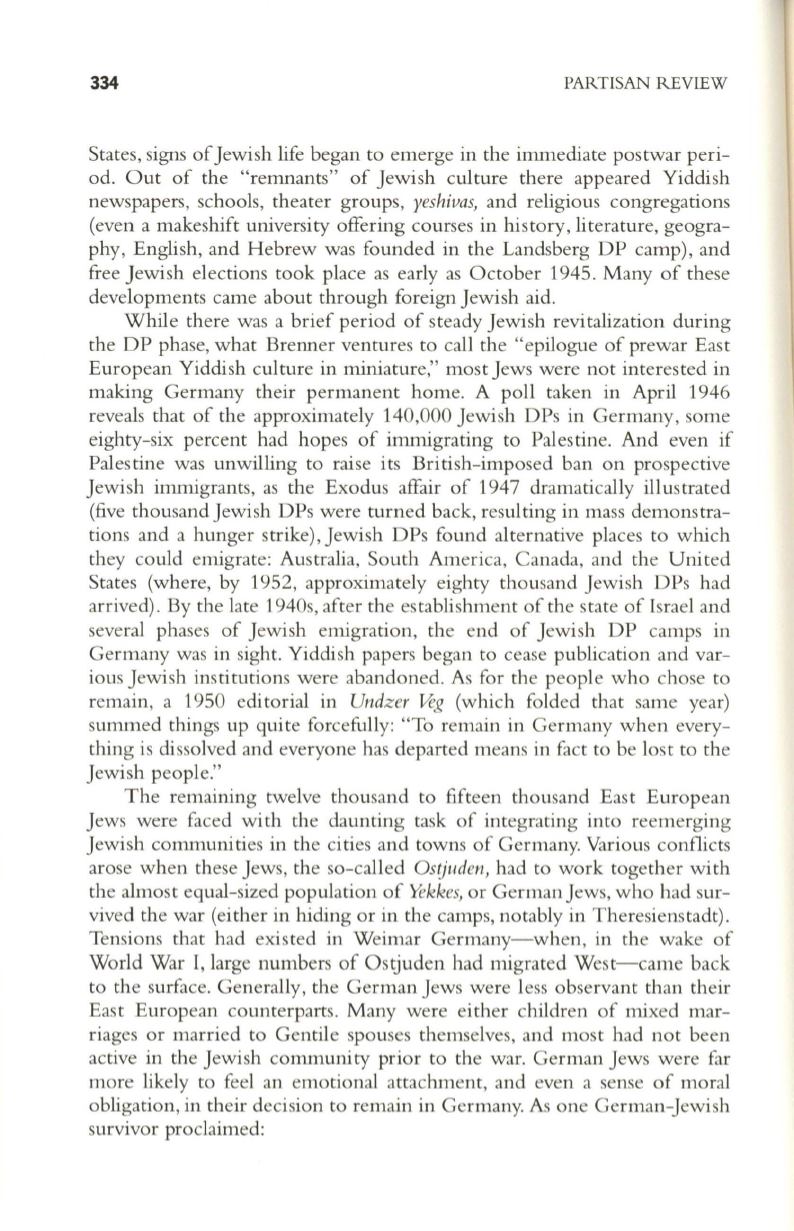
334
PARTISAN REVIEW
States, signs ofJewish life began to emerge in the immediate postwar peri–
od. Out of the "remnants" of Jewish culture there appeared Yiddish
newspapers, schools, theater groups,
yeshivas,
and religious congregations
(even a makeshift university offering courses in history, literature, geogra–
phy, English, and Hebr:ew was founded in the Landsberg DP camp), and
free Jewish elections took place as early as October 1945. Many of these
developments came about through foreign Jewish aid.
While there was a brief period of steady Jewish revitalization during
the DP phase, what Brenner ventures to call the "epilogue of prewar East
European Yiddish culture in miniature," most Jews were not interested in
making Germany their permanent home. A poll taken in April 1946
reveals that of the approximately 140,000 Jewish DPs in Germany, some
eighty-six percent had hopes of immigrating to Palestine. And even if
Palestine was unwilling to raise its British-imposed ban on prospective
Jewish immigrants, as the Exodus affair of 1947 dramatically illustrated
(five thousand Jewish DPs were turned back, resulting in mass demonstra–
tions and a hunger strike), Jewish DPs found alternative places to which
they could emigrate: Australia, South America, Canada, and the United
States (where, by 1952, approximately eighty thousand Jewish DPs had
arrived). By the late 1940s, after the establishment of the state of Israel and
several phases of Jewish emigration, the end of Jewish DP camps in
Germany was in sight. Yiddish papers began to cease publication and var–
ious Jewish institutions were abandoned. As for the people who chose to
remain, a 1950 editorial in
Undz er
!leg
(which folded that same year)
sumn1ed things up quite forcefully: "To remain in Germany when every–
thing is dissolved and everyone has departed means in fact to be lost to the
Jewish people."
The remaining twelve thousand to fifteen thousand East European
Jews were faced with the daunting task of integrating into reemerging
Jewish communities in the cities and towns of Germany. Various conflicts
arose when these Jews, the so-called
Ostjuden,
had to work together with
the almost equal-sized population of
Yekkes,
or German Jews, who had sur–
vived the war (either in hiding or in the camps, notably in Theresienstadt).
Tensions that had existed in Weimar Germany-when, in the wake of
World War
I,
large numbers of Ostjuden had migrated West-came back
to the surface. Generally, the German Jews were less observant than their
East European counterparts. Many were either children of mixed mar–
riages or married to Gentile spouses themselves, and most had not been
active in the Jewish community prior to the war. German Jews were far
more likely to feel an emotional attachment, and even a sense of moral
obligation, in their decision to remain in Germany. As one German-Jewish
survivor proclaimed:


